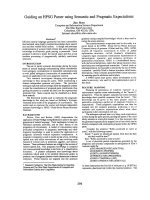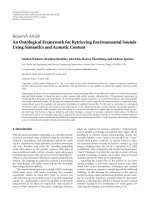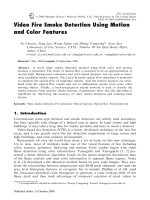Real-Time Embedded Multithreading Using ThreadX and MIPS- P12 pdf
Bạn đang xem bản rút gọn của tài liệu. Xem và tải ngay bản đầy đủ của tài liệu tại đây (153.36 KB, 20 trang )
Synchronization of Threads Using Event Flags Groups 2 2 3
www.newnespress.com
We arbitrarily set the event fl ags group to the value slow_fl ags in the preceding statement.
The only consequence of this particular initialization is that Speedy_Thread will be the
fi rst thread to execute. We could have set the event fl ags group to the value speedy_fl ags,
thereby giving Slow_Thread the fi rst opportunity to execute.
The remaining changes occur in the function defi nitions section of our program. We need
to change all references to a binary semaphore with references to an event fl ags group.
We will show only the changes for the Speedy_Thread and will leave the Slow_Thread
changes as an exercise for the reader. Figure 12.23 contains the necessary changes for
Activity 2.
Figure 12.24 contains the necessary changes for Activity 4. Most of the modifi cations
involve changing binary semaphore calls to event fl ags group calls.
/* Activity 2 - Wait for slow_flags in the event flags group,
set it to speedy_flags, and hold it for 5 timer-ticks. */
status = tx_event_flags_get (&my_event_group,
slow_flags, TX_AND_CLEAR,
&actual_events, TX_WAIT_FOREVER);
if (status != TX_SUCCESS) break; /* Check status. */
status = tx_event_flags_set (&my_event_group,
speedy_flags, TX_OR);
if (status != TX_SUCCESS) break; /* Check status. */
tx_thread_sleep(5);
Figure 12.23: Changes to Activity 2
/* Activity 4 - Wait for slow_flags in the event flags group,
set it to speedy_flags, and hold it for 3 timer-ticks. */
status = tx_event_flags_get (&my_event_group,
slow_flags, TX_AND_CLEAR,
&actual_events, TX_WAIT_FOREVER);
if (status != TX_SUCCESS) break; /* Check status. */
status = tx_event_flags_set (&my_event_group,
speedy_flags, TX_OR);
if (status != TX_SUCCESS) break; /* Check status. */
Figure 12.24: Changes to Activity 4
Please purchase PDF Split-Merge on www.verypdf.com to remove this watermark.
224 Chapter 12
12.11 Listing for 12_sample_system.c
The sample system named 12_sample_system.c is located on the attached CD. The
complete listing appears below; line numbers have been added for easy reference.
001 /* 12_sample_system.c
002
003 Create two threads and one event fl ags group.
004 The threads synchronize their behavior via the
005 event fl ags group. */
006
007
008 /****************************************************/
009 /* Declarations, Defi nitions, and Prototypes */
010 /****************************************************/
011
012 #include “tx_api.h”
013 #include Ͻ stdio.h Ͼ
014
015 #defi ne STACK_SIZE 1024
016
017 /* Declare stacks for both threads. */
018 CHAR stack_speedy[STACK_SIZE];
019 CHAR stack_slow[STACK_SIZE];
020
021 /* Defi ne the ThreadX object control blocks. */
022 TX_THREAD Speedy_Thread;
023 TX_THREAD Slow_Thread;
024 TX_EVENT_FLAGS_GROUP my_event_group;
025
026 /* Declare the application timer */
027 TX_TIMER stats_timer;
028
www.newnespress.com
Please purchase PDF Split-Merge on www.verypdf.com to remove this watermark.
Synchronization of Threads Using Event Flags Groups 2 2 5
www.newnespress.com
029 /* Declare the counters, accumulators, and fl ags */
030 ULONG Speedy_Thread_counter ϭ 0,
031 total_speedy_time ϭ 0;
032 ULONG Slow_Thread_counter ϭ 0,
033 total_slow_time ϭ 0;
034 ULONG slow_fl ags ϭ 0X0F,
035 speedy_fl ags ϭ 0XF0,
036 actual_events;
037
038 /* Defi ne thread prototypes. */
039 void Speedy_Thread_entry(ULONG thread_input);
040 void Slow_Thread_entry(ULONG thread_input);
041
042 /* Defi ne prototype for expiration function */
043 void print_stats(ULONG);
044
045
046 /****************************************************/
047 /* Main Entry Point */
048 /****************************************************/
049
050 /* Defi ne main entry point. */
051
052 int main()
053 {
054 /* Enter the ThreadX kernel. */
055 tx_kernel_enter();
056 }
057
058
059 /****************************************************/
060 /* Application Defi nitions */
061 /****************************************************/
062
063 /* Defi ne what the initial system looks like. */
064
065 void tx_application_defi ne(void *fi rst_unused_memory)
066 {
067 /* Put system defi nitions here,
068 e.g., thread and event fl ags group creates */
Please purchase PDF Split-Merge on www.verypdf.com to remove this watermark.
226 Chapter 12
069
070 /* Create the Speedy_Thread. */
071 tx_thread_create( & Speedy_Thread, “Speedy_Thread”,
072 Speedy_Thread_entry, 0,
073 stack_speedy, STACK_SIZE,
074 5, 5, TX_NO_TIME_SLICE, TX_AUTO_START);
075
076 /* Create the Slow_Thread */
077 tx_thread_create( & Slow_Thread, “Slow_Thread”,
078 Slow_Thread_entry, 1,
079 stack_slow, STACK_SIZE,
080 15, 15, TX_NO_TIME_SLICE, TX_AUTO_START);
081
082 /* Create the event fl ags group used by both threads,
083 initialize to slow_fl ags (0X0F). */
084 tx_event_fl ags_create ( & my_event_group, “my_event_group”);
085 tx_event_fl ags_set ( & my_event_group, slow_fl ags, TX_OR);
086
087 /* Create and activate the timer */
088 tx_timer_create ( & stats_timer, “stats_timer”, print_stats,
089 0x1234, 500, 500, TX_AUTO_ACTIVATE);
090
091 }
092
093
094 /****************************************************/
095 /* Function Defi nitions */
096 /****************************************************/
097
098 /* “Speedy_Thread” - it has a higher priority than the other
thread */
099
100 void Speedy_Thread_entry(ULONG thread_input)
101 {
102
103 UINT status;
104 ULONG start_time, cycle_time, current_time;
105
106 while(1)
107 {
www.newnespress.com
Please purchase PDF Split-Merge on www.verypdf.com to remove this watermark.
Synchronization of Threads Using Event Flags Groups 2 2 7
www.newnespress.com
108 /* Get the starting time for this cycle */
109 start_time ϭ tx_time_get();
110
111 /* Activity 1: 2 timer-ticks. */
112 tx_thread_sleep(2);
113
114 /* Activity 2 - Wait for slow_fl ags in the event
fl ags group, set it to speedy_fl ags, and hold it for
5 timer-ticks. */
115
116
117 status ϭ tx_event_fl ags_get ( & my_event_group, slow_
fl ags, TX_AND_CLEAR,
118 & actual_events, TX_WAIT_
FOREVER);
119 if (status ! ϭ TX_SUCCESS) break; /* Check status. */
120
121 status ϭ tx_event_fl ags_set ( & my_event_group, speedy_
fl ags, TX_OR);
122 if (status ! ϭ
TX_SUCCESS) break; /* Check status. */
123
124 tx_thread_sleep(5);
125
126 /* Activity 3: 4 timer-ticks. */
127 tx_thread_sleep(4);
128
129 /* Activity 4 - Wait for slow_fl ags in the event
fl ags group, set it to speedy_fl ags, and hold it for
3 timer-ticks. */
130
131
132 status ϭ tx_event_flags_get ( & my_event_group, slow_flags,
TX_AND_CLEAR,
133 & actual_events,
TX_WAIT_FOREVER);
134
135 if (status ! ϭ TX_SUCCESS) break; /* Check status. */
136
137 status ϭ tx_event_fl ags_set ( & my_event_group, speedy_
fl ags, TX_OR);
Please purchase PDF Split-Merge on www.verypdf.com to remove this watermark.
228 Chapter 12
138 if (status ! ϭ TX_SUCCESS) break; /* Check status. */
139
140 tx_thread_sleep(3);
141
142 /* Increment the thread counter and get timing info */
143 Speedy_Thread_counter ϩ ϩ ;
144
145 current_time ϭ tx_time_get();
146 cycle_time ϭ current_time - start_time;
147 total_speedy_time ϭ total_speedy_time ϩ cycle_time;
148
149 }
150 }
151
152 /*********************************************************/
153 /* “Slow_Thread” - it has a lower priority than the other
thread */
154
155 void Slow_Thread_entry(ULONG thread_input)
156 {
157
158 UINT status;
159 ULONG start_time, current_time, cycle_time;
160
161 while(1)
162 {
163 /* Get the starting time for this cycle */
164 start_time ϭ tx_time_get();
165
166 /* Activity 5 - Wait for speedy_fl ags in the event
fl ags group, set it to slow_fl ags, and hold it for
12 timer-ticks. */
167
168 status ϭ tx_event_flags_get ( & my_event_group, speedy_flags,
TX_AND_CLEAR,
169 & actual_events,
TX_WAIT_FOREVER);
170
171 if (status ! ϭ TX_SUCCESS) break; /* Check status. */
172
www.newnespress.com
Please purchase PDF Split-Merge on www.verypdf.com to remove this watermark.
Synchronization of Threads Using Event Flags Groups 2 2 9
www.newnespress.com
173 status ϭ tx_event_fl ags_set ( & my_event_group, slow_fl ags,
TX_OR);
174 if (status ! ϭ TX_SUCCESS) break; /* Check status. */
175
176 tx_thread_sleep(12);
177
178 /* Activity 6: 8 timer-ticks. */
179 tx_thread_sleep(8);
180
181 /* Activity 7: Wait for speedy_fl ags in the event fl ags
group, set it
182 to slow_fl ags, and hold it for 11 timer-ticks. */
183
184 status ϭ tx_event_flags_get ( & my_event_group, speedy_flags,
TX_AND_CLEAR,
185 & actual_events,
TX_WAIT_FOREVER);
186
187 if (status ! ϭ TX_SUCCESS) break; /* Check status. */
188
189 status ϭ tx_event_fl
ags_set ( & my_event_group, slow_fl ags,
TX_OR);
190
191 tx_thread_sleep(11);
192
193 /* Activity 8: 9 timer-ticks. */
194 tx_thread_sleep(9);
195
196 /* Increment the thread counter and get timing info */
197 Slow_Thread_counter ϩ ϩ ;
198
199 current_time ϭ tx_time_get();
200 cycle_time ϭ current_time - start_time;
201 total_slow_time ϭ total_slow_time ϩ cycle_time;
202
203 }
204 }
205
206 /*****************************************************/
207 /* print statistics at specifi ed times */
Please purchase PDF Split-Merge on www.verypdf.com to remove this watermark.
230 Chapter 12
208 void print_stats (ULONG invalue)
209 {
210 ULONG current_time, avg_slow_time, avg_speedy_time;
211
212 if ((Speedy_Thread_counter Ͼ 0) && (Slow_Thread_counter Ͼ 0))
213 {
214 current_time ϭ tx_time_get();
215 avg_slow_time ϭ total_slow_time / Slow_Thread_counter;
216 avg_speedy_time ϭ total_speedy_time /
Speedy_Thread_counter;
217
218 printf(“\nEvent Flags Group synchronizes 2 threads\n”);
219 printf(“ Current Time: %lu\n”,
220 current_time);
221 printf(“ Speedy_Thread counter: %lu\n”,
222 Speedy_Thread_counter);
223 printf(“ Speedy_Thread avg time: %lu\n”,
224 avg_speedy_time);
225 printf(“ Slow_Thread counter: %lu\n”,
226 Slow_Thread_counter);
227 printf(“ Slow_Thread avg time: %lu\n\n”,
228 avg_slow_time);
229 }
230 else printf(“ Bypassing print_stats function, Current
Time: %lu\n”, tx_time_get());
231
232 }
12.12 Event Flags Group Internals
When the TX_EVENT_FLAGS data type is used to declare an event fl ags group, an ECB
is created, and that Control Block is added to a doubly linked circular list, as illustrated in
Figure 12.25 .
When fl ags become set in an event fl ags group, ThreadX immediately reviews all threads
that are suspended on that event fl ags group. This introduces some overhead, so limit the
number of threads using the same event fl ags group to a reasonable number.
www.newnespress.com
Please purchase PDF Split-Merge on www.verypdf.com to remove this watermark.
Synchronization of Threads Using Event Flags Groups 2 3 1
www.newnespress.com
12.13 Overview
Event fl ags provide a powerful tool for thread synchronization. Event fl ags groups do not
support a concept of ownership, nor is there a limit to how many threads can access an
event fl ags group.
Event fl ags can be set by any thread and can be inspected by any thread.
Threads can suspend while waiting for some combination of event fl ags to be set.
Threads can operate on all 32 event fl ags in a group simultaneously. Threads can set or
clear event fl ags using the tx_event_fl ags_set service and get them (wait on them) by
using the tx_event_fl ags_get service.
The clearing or setting of event fl ags entails a logical TX_AND or TX_OR operation
between the current event fl ags and the new event fl ags. There are similar logical options
for getting event fl ags. A get request can specify that all specifi ed event fl ags are required
(a logical TX_AND). Alternatively, a get request can specify that any of the specifi ed
event fl ags will satisfy the request (a logical TX_OR).
Event fl ags that satisfy a get request are cleared if either of the clear options TX_ OR_
CLEAR or TX_AND_CLEAR are specifi ed by the request. The event fl ag values remain
unchanged when the TX_AND or TX_OR options are used in a get request.
Application threads can suspend while attempting to get any logical combination of
event fl ags from a group. When at least one event fl ag becomes set, the get requests of
ECB 1 ECB 2 ECB 3 ECB n
tx_event_flags_created_ptr
…
Figure 12.25: Created event fl ags group list
Please purchase PDF Split-Merge on www.verypdf.com to remove this watermark.
232 Chapter 12
all threads suspended on that event fl ags group are reviewed. All the threads whose get
requests are now satisfi ed are resumed.
As noted above, when at least one fl ag of a group becomes set, ThreadX reviews all the
threads suspended on that group. This review process creates overhead, so try to limit the
number of threads using the same event fl ags group to a reasonable number.
12.14 Key Terms and Phrases
clearing event fl ags initialization of event fl ags
creating an event fl ags group logical operations
deleting an event fl ags group retrieval of event fl ags
event fl ags group satisfying a get request
Event Flags Group Control Block (ECB) set option setting event fl ags
fl ag suspension of threads
get option synchronization of threads
get request wait option
12.15 Problems
1. Compare mutexes, counting semaphores, and event fl ags groups. Describe three different
scenarios in which using each object is better suited than using the other two objects.
2. Describe how you would determine how many threads are suspended for a certain
event fl ags group.
3. Describe how you would determine the current value of an event fl ags group.
4. Suppose that you want to synchronize the operation of three threads. Describe how
you would use an event fl ags group so that the threads are processed in a specifi c
order, i.e., so that your application processes the fi rst thread, the second thread, and
then the third thread. (This process order is to repeat indefi nitely.)
5. Suppose that you want to synchronize the operation of three threads. Describe
how you would use an event fl ags group so that, at most, two of the threads can be
processed at any time, but the third thread depends on one of the other two threads
before it can execute.
www.newnespress.com
Please purchase PDF Split-Merge on www.verypdf.com to remove this watermark.
Synchronization of Threads Using Event Flags Groups 2 3 3
www.newnespress.com
6. Suppose that an event fl ags group contains one of the values 0x110, 0x101, or 0x011.
Describe how you would perform a get operation that would be satisfi ed for any one
of these values.
7. If an event fl ags group had the value 0xFDB, what successful get operation could
have caused the value of this group to change to 0xBDA?
8. If an event fl ags group had the value 0xF4C, what successful set operation could have
cause the value of this group to change to 0x148?
Please purchase PDF Split-Merge on www.verypdf.com to remove this watermark.
www.newnespress.com
Thread Communication with
Message Queues
CHAPTER 13
13.1 Introduction
Message queues are the primary means of interthread communication in ThreadX. One
or more messages can reside in a message queue, which generally observes a FIFO
discipline. A message queue that can hold just a single message is commonly called a
mailbox.
The tx_queue_send service places messages in the rear of a queue and the tx_queue_
receive service removes messages from the front of a queue. The only exception to this
protocol occurs when a thread is suspended while waiting for a message from an empty
queue. In this case, ThreadX places the next message sent to the queue directly into the
thread’s destination area, thus bypassing the queue altogether. Figure 13.1 illustrates a
message queue.
Each message queue is a public resource. ThreadX places no constraints on how message
queues are used.
Applications can create message queues either during initialization or during runtime.
There is no limit to the number of message queues an application may use.
Messages inserted at rear of queue Messages removed from front of queue
Message_n Message_3 Message_2 Message_1• • •
Figure 13.1: A message queue
Please purchase PDF Split-Merge on www.verypdf.com to remove this watermark.
236 Chapter 13
Message queues can be created to support a variety of message sizes. The available
message sizes are 1, 2, 4, 8, and 16 32-bit words. The message size is specifi ed when
the queue is created. If your application messages exceed 16 words, you must send your
messages by pointer. To accomplish this, create a queue with a message size of one word
(enough to hold a pointer), and then send and receive message pointers instead of the
entire message.
The number of messages a queue can hold depends on its message size and the size of
the memory area supplied during creation. To calculate the total message capacity of the
queue, divide the number of bytes in each message into the total number of bytes in the
supplied memory area.
For example, if you create a message queue that supports a message size of one 32-bit
word (four bytes), and the queue has a 100-byte available memory area, its capacity is 25
messages.
The memory area for buffering messages is specifi ed during queue creation. It can be
located anywhere in the target’s address space. This is an important feature because it
gives the application considerable fl exibility. For example, an application might locate the
memory area of a very important queue in high-speed RAM to improve performance.
Application threads can suspend while attempting to send or receive a message from a
queue. Typically, thread suspension involves waiting for a message from an empty queue.
However, it is also possible for a thread to suspend trying to send a message to a full
queue.
After the condition for suspension is resolved, the request completes and the waiting
thread is resumed. If multiple threads are suspended on the same queue, they are resumed
in the order they occur on the suspended list (usually FIFO). However, an application can
cause a higher-priority thread to resume fi rst by calling the tx_queue_prioritize service
prior to the queue service that lifts thread suspension. The queue prioritize service places
the highest-priority thread at the front of the suspension list, while leaving all other
suspended threads in the same FIFO order.
Queue suspensions can also time out; essentially, a time-out specifi es the maximum
number of timer-ticks the thread will stay suspended. If a time-out occurs, the thread is
resumed and the service returns with the appropriate error code.
www.newnespress.com
Please purchase PDF Split-Merge on www.verypdf.com to remove this watermark.
Thread Communication with Message Queues 2 3 7
www.newnespress.com
13.2 Message Queue Control Block
The characteristics of each message queue are found in its Control Block. It contains
information such as the message size, total message capacity, current number of messages
in the queue, available queue storage space, and number of threads suspended on this
message queue.
1
Figure 13.2 contains many of the fi elds that comprise this Control
Block.
A Message Queue Control Block can be located anywhere in memory, but it is common
to make the Control Block a global structure by defi ning it outside the scope of any
function. A Message Queue Group Control Block is created when a message queue
is declared with the TX_QUEUE data type. For example, we declare my_queue as
follows:
TX_QUEUE my_queue;
The declaration of a message queue normally appears in the declarations and defi nitions
section of the program.
Field
tx_queue_id
tx_queue_name
tx_queue_message_size
tx_queue_capacity
tx_queue_enqueued
tx_queue_available_storage
tx_queue_start
x_queue_end
tx_queue_read
tx_queue_write
tx_queue_suspension_list
tx_queue_suspended_count
tx_queue_created_next
tx_queue_created_previous
Description
Message Queue ID
Pointer to message queue name
Message size specified during queue creation
Total number of messages in the queue
Current number of messages in the message queue
Available message queue storage space
Pointer to the start of the queue message area
Pointer to the end of the queue message area
Read pointer—used by receive requests
Write pointer—used by send requests
Pointer to the head of the queue suspension list
Count of how many threads are suspended
Pointer to next message queue in the created list
Pointer to previous message queue in created list
Figure 13.2: Message Queue Control Block
1
The structure of the Message Queue Control Block is defi ned in the tx_api.h fi le.
Please purchase PDF Split-Merge on www.verypdf.com to remove this watermark.
238 Chapter 13
13.3 Summary of Message Queue Services
Appendix F contains detailed information about message queue services. This appendix
contains information about each service, such as the prototype, a brief description of the
service, required parameters, return values, notes and warnings, allowable invocation,
and an example showing how the service can be used. Figure 13.3 contains a listing of all
available services for a message queue. We will investigate each of these services in the
subsequent sections of this chapter.
13.4 Creating a Message Queue
A message queue is declared with the TX_QUEUE data type and is defi ned with the
tx_queue_create service. When defi ning a message queue, you must specify its Control
Block, the name of the message queue, the message size, the starting address of the
www.newnespress.com
Message Queue Service
tx_queue_create
tx_queue_delete
tx_queue_flush
tx_queue_front_send
tx_queue_info_get
tx_queue_performance_info_get
tx_queue_performance_system_info_get
tx_queue_prioritize
tx_queue_receive
tx_queue_send
tx_queue_send_notify
Description
Create a message queue
Delete a message queue
Empty all messages in a
message queue
Send a message to the front of a
message queue
Retrieve information about a
message queue
Get queue performance
information
Get queue system performance
information
Prioritize a message queue
suspension list
Get a message from a message
queue
Send a message to a message
queue
Notify application when message
is sent to queue
Figure 13.3: Services of the message queue
Please purchase PDF Split-Merge on www.verypdf.com to remove this watermark.
Thread Communication with Message Queues 2 3 9
www.newnespress.com
queue, and the total number of bytes available for the message queue. Figure 13.4 lists
the attributes of a message queue. The total number of messages is calculated from the
specifi ed message size and the total number of bytes in the queue. Note that if the total
number of bytes specifi ed in the queue’s memory area is not evenly divisible by the
specifi ed message size, the remaining bytes in the memory area are not used.
Figure 13.5 illustrates the use of this service. We will give our message queue the name
“ my_queue. ”
13.5 Sending a Message to a Message Queue
The tx_queue_send service sends a message to the specifi ed message queue. This service
copies the message to be sent to the back of the queue from the memory area specifi ed by
Message queue control block
Message queue name
Size of each message in the queue
Address of the message queue
Total number of bytes for the message queue
Figure 13.4: Attributes of a message queue
TX_QUEUE my_queue;
UINT status;
/* Create a message queue whose total size is 2000 bytes
starting at address 0x300000. Each message in this
queue is defined to be 4 32-bit words long. */
status = tx_queue_create(&my_queue, "my_queue_name",
TX_4_ULONG, (VOID *) 0x300000, 2000);
/* If status equals TX_SUCCESS, my_queue contains space
for storing 125 messages: (2000 bytes / 16 bytes per message). */
Figure 13.5: Creating a message queue
Please purchase PDF Split-Merge on www.verypdf.com to remove this watermark.
240 Chapter 13
the source pointer. Figure 13.6 shows how this service can be used to send a message to a
queue.
2
If return variable status contains the value TX_SUCCESS, we have successfully sent a
message to the queue.
13.6 Receiving a Message from a Message Queue
The tx_queue_receive service retrieves a message from a message queue. This service
copies the retrieved message from the front of the queue into the memory area specifi ed
by the destination pointer. That message is then removed from the queue. The specifi ed
destination memory area must be large enough to hold the message; i.e., the destination
pointed to by destination_ptr must be at least as large as this queue’s defi ned message
size. Otherwise, memory corruption occurs in the memory area following the destination.
Figure 13.7 shows how this service can be used to receive a message from a queue.
3
www.newnespress.com
TX_QUEUE my_queue;
UINT status;
ULONG my_message[4];
…
/* Send a message to "my_queue." Return immediately,
regardless of success. This wait option is used for
calls from initialization, timers, and ISRs. */
status = tx_queue_send(&my_queue, my_message, TX_NO_WAIT);
/* If status equals TX_SUCCESS, the message has been sent
to the queue. */
Figure 13.6: Send a message to a queue
2
Note that TX_NO_WAIT is the only valid wait option if this service is called from a non-thread,
such as an application timer, initialization routine, or ISR.
3
Note that TX_NO_WAIT is the only valid wait option if this service is called from a non-thread,
such as an application timer, initialization routine, or ISR.
Please purchase PDF Split-Merge on www.verypdf.com to remove this watermark.
Thread Communication with Message Queues 2 4 1
www.newnespress.com
13.7 Deleting a Message Queue
The tx_queue_delete service deletes a message queue. All threads that are suspended
waiting for a message from this queue are resumed and receive a TX_DELETED return
status. Do not attempt to use a message queue that has been deleted. Also, make certain
that you manage the memory area associated with a queue that has been deleted. Figure
13.8 contains an example showing how to delete a message queue.
If variable status contains the return value TX_SUCCESS, we have successfully deleted
the message queue.
TX_QUEUE my_queue;
UINT status;
ULONG my_message[4];
…
/* Retrieve a message from "my_queue." If the queue is
empty, suspend until a message is present. Note that
this suspension is only possible from application
threads. */
status = tx_queue_receive(&my_queue, my_message,
TX_WAIT_FOREVER);
/* If status equals TX_SUCCESS, the message is in
"my
_
message." */
Figure 13.7: Receive a message from a queue
TX_QUEUE my_queue;
UINT status;
…
/* Delete entire message queue. Assume that the
queue has already been created with a call to
tx_queue_create. */
status = tx_queue_delete(&my_queue);
/* If status equals TX_SUCCESS, the message queue
has been deleted. */
Figure 13.8: Deleting a message queue
Please purchase PDF Split-Merge on www.verypdf.com to remove this watermark.
242 Chapter 13
13.8 Flushing the Contents of a Message Queue
The tx_queue_fl ush service deletes all messages that are stored in a message queue. In
addition, if the queue is full and there are threads suspended because of trying to send
messages to that queue, then all the messages of those suspended threads are discarded,
and each suspended thread is resumed with a successful return status. If the queue is
empty, this service does nothing.
Figure 13.9 illustrates the use of this service. We will give our message queue the name
“ my_queue. ”
If variable status contains the return value TX_SUCCESS, we have successfully emptied
the message queue.
13.9 Sending a Message to the Front of a Message Queue
Normally, messages are sent to the rear of a queue, but applications can use the tx_
queue_front_send service to send a message to the front location of the message queue.
This service copies the message to the front of the queue from the memory area specifi ed
by the source pointer. Figure 13.10 illustrates the use of this service. We will give our
message queue the name “ my_queue ” and we will use the wait option that returns
immediately, regardless of whether or not the message was successfully placed at the
front of the queue. If the variable status contains the return value TX_SUCCESS, we
have successfully sent a message to the front of a queue.
www.newnespress.com
TX_QUEUE my_queue;
UINT status;
…
/* Delete all messages in the message queue.
Assume that the queue has already been created
with a call to tx_queue_create. */
status = tx_queue_flush(&my_queue);
/* If status equals TX_SUCCESS, the message queue
is now empty. */
Figure 13.9: Flushing a message queue
Please purchase PDF Split-Merge on www.verypdf.com to remove this watermark.
Thread Communication with Message Queues 2 4 3
www.newnespress.com
13.10 Retrieving Message Queue Information
There are three services that enable you to retrieve vital information about message
queues. The fi rst such service for message queues — the tx_queue_info_get service —
retrieves a subset of information from the Message Queue Control Block. This
information provides a “ snapshot ” at a particular instant in time, i.e., when the service
is invoked. The other two services provide summary information that is based on the
gathering of run-time performance data. One service — the tx_queue_performance_
info_get service — provides an information summary for a particular queue up to the
time the service is invoked. By contrast the tx_queue_performance_system_info_get
retrieves an information summary for all message queues in the system up to the time the
service is invoked. These services are useful in analyzing the behavior of the system and
determining whether there are potential problem areas. The tx_queue_info_get
4
service
retrieves several useful items of information about a message queue. These include the
name of the message queue, the number of messages currently in the queue, the queue’s
total available storage (in bytes), the number of threads suspended for this queue, a
pointer to the fi rst suspended thread, and a pointer to the next created message queue.
Figure 13.11 shows how this service can be used.
TX_QUEUE my_queue;
UINT status;
ULONG my_message[TX_4_ULONG];
…
/* Send a message to the front of "my_queue." Return
immediately, regardless of success. This wait
option is used for calls from initialization,
timers, and ISRs. */
status = tx_queue_front_send(&my_queue, my_message,
TX_NO_WAIT);
/* If status equals TX_SUCCESS, the message has been
placed at the front of the specified queue. */
Figure 13.10: Sending a message to the front of a queue
4
By default, only the tx_queue_info_get service is enabled. The other two information-gathering
services must be enabled in order to use them.
Please purchase PDF Split-Merge on www.verypdf.com to remove this watermark.









